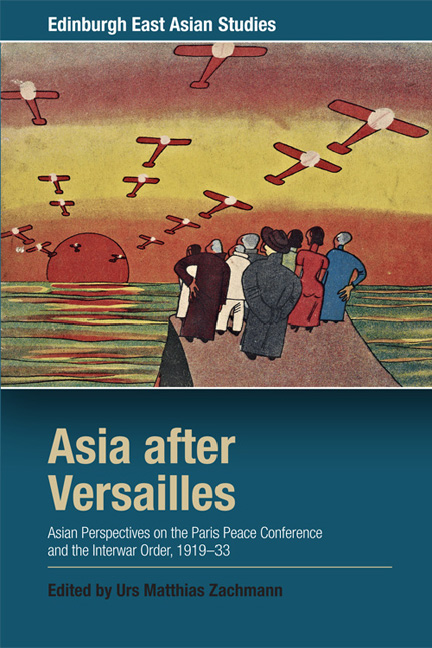 Asia after Versailles
Asia after Versailles Book contents
- Frontmatter
- Contents
- List of Illustrations
- Notes on Contributors
- Acknowledgments
- Introduction: Asia After Versailles
- Part I
- Part II
- 4 A Cultural History of Diplomacy: Reassessing the Japanese ‘Performance’ at the Paris Peace Conference
- 5 India's Freedom and the League of Nations: Public Debates 1919–33
- 6 Dashed Hopes: Japanese Buddhist Perspectives on the Paris Peace Conference
- 7 Particularism and Universalism in the New Nationalism of Post-Versailles Japan
- 8 Versailles and the Fate of Chinese Internationalism: Reassessing the Anarchist Case
- 9 The Impact of Versailles on Chinese Nationalism as Reflected in Shanghai Graphic and Urban Culture, 1919–31
- Index
9 - The Impact of Versailles on Chinese Nationalism as Reflected in Shanghai Graphic and Urban Culture, 1919–31
from Part II
Published online by Cambridge University Press: 22 December 2017
- Frontmatter
- Contents
- List of Illustrations
- Notes on Contributors
- Acknowledgments
- Introduction: Asia After Versailles
- Part I
- Part II
- 4 A Cultural History of Diplomacy: Reassessing the Japanese ‘Performance’ at the Paris Peace Conference
- 5 India's Freedom and the League of Nations: Public Debates 1919–33
- 6 Dashed Hopes: Japanese Buddhist Perspectives on the Paris Peace Conference
- 7 Particularism and Universalism in the New Nationalism of Post-Versailles Japan
- 8 Versailles and the Fate of Chinese Internationalism: Reassessing the Anarchist Case
- 9 The Impact of Versailles on Chinese Nationalism as Reflected in Shanghai Graphic and Urban Culture, 1919–31
- Index
Summary
Nationalism and the New Culture and May Fourth Movements
Following its inauguration as the first Asian republic in 1912, China was profoundly affected by the outbreak of the First World War in the early days of its national formation. The impact was further amplified by the Russian Revolution, which followed a few years later. Japan had made Korea its protectorate in 1905 as a foothold for the invasion of Manchuria, before annexing the country in 1910. Furthermore, when the First World War broke out, Japan moved quickly to appropriate German interests in the Shandong Peninsula by taking advantage of the diminishing presence of the Western powers, who were now preoccupied with the war in Europe. After the murder of a German missionary in the Shandong Peninsula in 1897, German troops had occupied Jiaozhou (Kiaochow) Bay in Tsingtao (Qingdao), and then the city as a whole on the pretext of protecting German missionaries. Since 1898, Tsingtao had been a leased territory of Germany. Now, however, Japan declared war against Germany in August 1914 when the war broke out, ostensibly citing the Anglo- Japanese Alliance. In addition, in September of the same year, Japanese troops landed in Shandong, claiming that the province was under German rule, despite China having already declared its neutrality in the war. In the following month, Japanese troops occupied Jinan, and in November, Tsingtao. These actions prompted local Chinese to start organising a movement for regaining their territory. In January 1915, Japan served the Twenty-One Demands to China, which were accepted by the then government of Yuan Shikai on 9 May. The day soon became known as National Humiliation Day in China. In August 1917, shortly before Germany's surrender, China entered the war. There were growing expectations among the Chinese that the return to China of the rights to the Shandong Peninsula would be decided at the Paris Peace Conference, given that US President Woodrow Wilson had announced his Fourteen Point peace programme upholding the principles of self-determination and of fair solutions to colonial problems.
- Type
- Chapter
- Information
- Asia after VersaillesAsian Perspectives on the Paris Peace Conference and the Interwar Order, 1919-33, pp. 212 - 236Publisher: Edinburgh University PressPrint publication year: 2017
